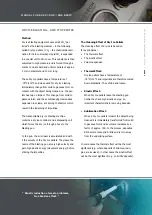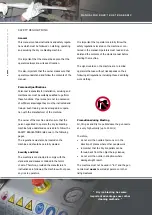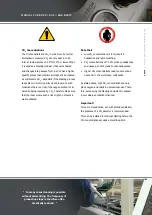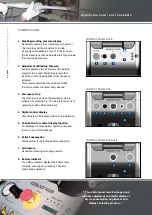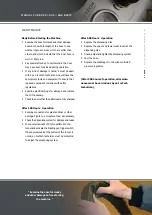
MANUAL for kg20 kg6 kg6 bAsic
dr
y
ic
e
bl
a
sting
eq
uipm
ent
fro
m
icetech
|
P
A
ge
co
2
concentrations
the dry ice pellets are co
2
in solid form. at normal
atmospheric pressure, co
2
can only exist in solid
form at temperatures of –79°c/110°f or lower. When
it is used as a blasting medium it becomes heated
and changes into gaseous form. as co
2
has a higher
specific
gravity than ordinary atmospheric air, inhaled
air will contain co
2
– especially if the blasting process
takes place in small or partly closed rooms. in such
conditions there is a risk of the oxygen content of in-
haled air being replaced by co
2
. therefore make sure
that the room where such a risk might be present is
well ventilated.
Note that:
• low co
2
concentrations (3-5%) result in
headaches and rapid breathing.
• co
2
concentrations of 7-10% produce headaches
and nausea, and may lead to unconsciousness.
• higher co
2
concentrations lead to unconscious-
ness and, in the worst case, suffocation.
as stated above, high co
2
concentrations can dis-
place oxygen and result in unconsciousness. there-
fore, avoid using the blasting equipment in spaces/
rooms where ventilation is limited.
important!
in rooms, closed tanks, etc. with limited ventilation,
the presence of a co
2
detector is recommended.
this can be installed to interrupt blasting before the
co
2
concentration exceeds a prescribed limit.
“ in many cases cleaning is possible
without dismantling. The frequency of
production stops is therefore often
drastically reduced. ”
MANUAL for kg20 kg6 kg6 bAsic
dr
y
ic
e
bl
a
sting
eq
uipm
ent
fro
m
icetech
|
P
A
ge
6
static electricity
serious discharge of static electricity can occur.
always make sure that objects to be cleaned are
adequately earthed and that this connection remains
stable throughout the whole cleaning process.
the dry ice blasting machine is earthed, from ma-
chine cabinet to blasting gun, and through the main
electricity connection on the rear side of the machine
– provided that the machine has been installed as
described under starting the machine pages 16.
Danger of burns
at atmospheric pressure, co
2
in solid form has a
temperature of -79°c/110°f or lower and can give
rise to serious burning on skin contact.
important!
therefore, always read the health and safety data
sheet provided by the dry ice supplier, and follow the
instructions given.
Danger of Thrown Loose objects
there is a risk of dry ice and small objects being
thrown back. Therefore small objects must be
firmly
secured before blasting – and loose objects must not
be left in the area where the cleaning process is to
take place.
the operator must always wear approved protective
goggles or a protective shield when working with
the blasting equipment. this also applies to other
personnel in the vicinity of the workspace.
Noise
in order to avoid noise stress, operators must always
wear approved ear protection when working with the
blasting equipment. because of the high air velocities
in the gun nozzle during dry ice blasting, the level
of noise in the area where operators work can reach
85-115 db(a). other personnel in the vicinity must
also be offered ear protection if the noise exceeds
80 db(a). ear protection is recommended under all
circumstances. it is important that the work area be
marked with the mandatory signs (blue) showing the
ear protection symbol where the use of ear protection
is required.
“ Dry ice pellets are non-toxic, non-abrasive
and free of moisture. Therefore, dry ice
blasting is applicable for a large number of
industries. ”




